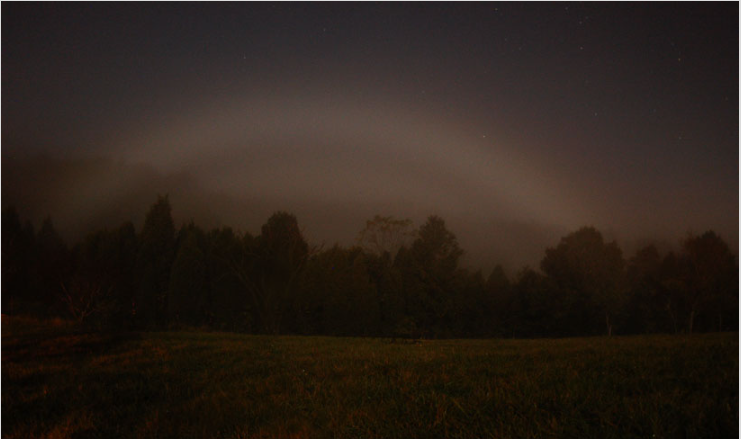Lunar fogbow
Lunar Fogbow: A Mystical Phenomenon in the Night Sky
Have you ever gazed up at the night sky and been captivated by the beauty of the moon? Well, prepare to be amazed by an even more enchanting sight: the lunar fogbow. This ethereal phenomenon occurs when a radiant fog forms under a clear night sky and the moon's glow interacts with tiny water droplets in the air. In this article, we will delve deeper into the world of lunar fogbows, exploring their formation, characteristics, and the mesmerizing visuals they create.
The Formation of Lunar Fogbows
Lunar fogbows are born from a delicate interplay between nature's elements. As the ground cools during the night, it releases heat into space, causing the surface temperature to drop. This drop in temperature chills the adjacent air, creating a radiation fog. This fog consists of tiny water droplets suspended in the atmosphere, forming a misty veil that blankets the landscape.
Unveiling the Lunar Fogbow
To witness a lunar fogbow, one needs a clear night sky and a sufficiently bright moon. When these conditions align, the moon's light interacts with the water droplets in the fog, leading to a captivating display of colors. The lunar fogbow appears as a faint, whitish arc stretching across the sky, similar to its daytime counterpart, the rainbow.
The Enigmatic Supernumerary Arc
Within the main lunar fogbow, one might observe an additional feature known as the supernumerary arc. This broad, ghostly arc appears inside the primary bow and adds an extra layer of intrigue to the spectacle. The supernumerary arc is caused by light waves diffracting around the water droplets, resulting in interference patterns that manifest as subtle bands of color.
A Play of Colors
While lunar fogbows lack the vibrant hues seen in rainbows, they still exhibit a subtle color palette. The inner edge of the bow tends to be tinged with pale red, while the outer edge takes on a bluish hue. The colors gradually fade as they move away from the center, creating a soft and ethereal aesthetic.
Similarities and Differences with Rainbows
Lunar fogbows share some similarities with rainbows but also possess distinct characteristics. Both phenomena arise from the interaction of light with water droplets, creating an arc-shaped display. However, fogbows lack the intense colors of rainbows due to the smaller size of the water droplets and the absence of sunlight. Instead, lunar fogbows showcase a more subdued and ghostly appearance.
Capturing the Lunar Fogbow
Photographing a lunar fogbow can be quite challenging due to its faint nature. Long exposure times and careful camera settings are often required to capture the ethereal beauty of this phenomenon. Skilled photographers have managed to immortalize lunar fogbows, allowing us to marvel at their enchanting allure.
The Allure of Lunar Fogbows
Lunar fogbows possess a mystical charm that enchants all who witness them. Their ethereal glow against the dark night sky evokes a sense of wonder and mystery. These rare occurrences serve as a reminder of the beauty and complexity of our natural world, reminding us to look up and appreciate the celestial wonders that surround us.
In conclusion, lunar fogbows are a captivating atmospheric phenomenon that adds a touch of magic to our nocturnal skies. Formed through the interplay of cooling temperatures, radiant fog, and moonlight, these ghostly arcs leave us in awe of nature's artistic prowess. So, keep your eyes peeled on those clear nights when the moon is shining bright, for you might just catch a glimpse of a lunar fogbow and experience the enchantment it brings.

Ohio lunar fogbow. At night under a clear sky the ground radiates heat away to space. The surface cools and this in turn cools the adjacent air to form a radiation fog. If there is a bright enough moon then a lunar fogbow might be visible. This example was imaged by Michael Ellestad (atmospheric optics site) in October 2004. A broad supernumerary arc is visible inside the main bow. Another lunar fogbow. ©2004 Michael Ellestad, shown with permission.
Note: this article has been automatically converted from the old site and may not appear as intended. You can find the original article here.
Reference Atmospheric Optics
If you use any of the definitions, information, or data presented on Atmospheric Optics, please copy the link or reference below to properly credit us as the reference source. Thank you!
-
<a href="https://atoptics.co.uk/blog/lunar-fogbow/">Lunar fogbow</a>
-
"Lunar fogbow". Atmospheric Optics. Accessed on December 26, 2024. https://atoptics.co.uk/blog/lunar-fogbow/.
-
"Lunar fogbow". Atmospheric Optics, https://atoptics.co.uk/blog/lunar-fogbow/. Accessed 26 December, 2024
-
Lunar fogbow. Atmospheric Optics. Retrieved from https://atoptics.co.uk/blog/lunar-fogbow/.